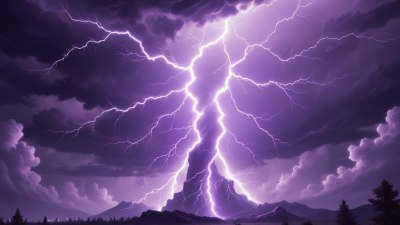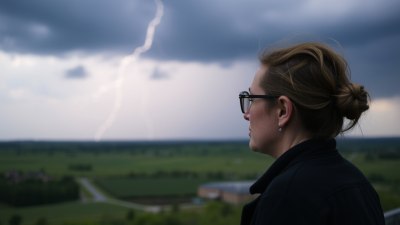Why Even the Weather App Gives You Mixed Signals Some Days
Explore why weather apps can give conflicting forecasts and how they determine changing weather patterns.

This image was created with the assistance of DALL·E
Weather apps have become an essential part of our daily routine, providing us with crucial information about temperature, precipitation, and other meteorological phenomena. However, many users often find themselves experiencing confusion and frustration due to the mixed signals that these applications seem to deliver on certain days. So why is it that these seemingly straightforward tools can produce conflicting forecasts? This exploration dives into several key factors that contribute to this phenomenon.
The Nature of Weather
First and foremost, it's important to understand the inherently chaotic nature of weather. The atmosphere is an incredibly complex system, influenced by a multitude of factors that can change rapidly. Variables such as temperature, humidity, atmospheric pressure, and wind patterns interact in unpredictable ways, which can lead to sudden changes in weather conditions. Weather is not static; it’s dynamic and sometimes unpredictable, even for the most advanced meteorological models.
Data Collection Techniques
Weather apps typically rely on data from various sources, including weather satellites, radar systems, and weather stations located around the globe. These data collection techniques involve gathering vast amounts of information and interpreting it to generate forecasts. However, the effectiveness of these methods can vary due to factors such as geographical limitations and sensor inaccuracies. For instance, in areas with sparse data coverage, the weather information might be less reliable. Consequently, discrepancies can arise when weather apps use this data to generate forecasts, leading to mixed signals.
Forecast Models
Forecasting weather accurately involves complex mathematical models that visualize meteorological conditions over time. Different weather apps may rely on different models, interpreting the collected data in various ways. Some models may emphasize certain aspects of the weather while downplaying others, leading to conflicting forecasts. For example, one app may predict rain based on a model that forecasts moisture in the atmosphere, while another app may not account for it sufficiently, resulting in a sunny outlook. This discrepancy can leave users bewildered, especially if they receive opposing predictions from multiple sources.
User Location
Another contributing factor is the user's location. Weather apps often use geolocation to provide forecasts tailored to specific areas. If a user is situated at the boundary of two different weather systems, even a small change in the user's position can result in significantly different weather conditions. For instance, if you live on the edge of a rainstorm, the weather app may predict sunny conditions for you while users just a few miles away may be advised to take their umbrellas. This localized variation can lead to confusion, as the same weather event can yield starkly different forecasts depending on where you are located.
Temporal Changes
Additionally, weather is highly time-sensitive. A forecast generated early in the morning may drastically differ from one produced in the afternoon or evening due to changing atmospheric conditions. For instance, a morning forecast could call for sunshine and clear skies, but by the afternoon, a cold front might push through, causing rain and cooler temperatures. Weather apps that rely on real-time data retrieval may provide updated forecasts at different intervals, which can contribute to perceived inconsistencies in the app's reporting.
Human Interpretation
An often-overlooked element is the aspect of human interpretation. Meteorologists analyze data and derive conclusions based on their experience and knowledge of weather patterns. This human aspect adds a layer of subjectivity to the forecasting process. Different meteorologists may place varying levels of importance on particular data, leading to differing interpretations and thus forecast discrepancies. These variations can then be reflected in the apps that utilize their insights, resulting in mixed signals.
Technological Limitations
Despite advancements in technology, weather forecasting is not infallible. Various limitations exist in the algorithms used by weather apps, including limitations in data processing and algorithm performance in certain weather scenarios. For instance, severe weather events such as hurricanes or tornadoes are notoriously difficult to predict accurately, and last-minute changes in these situations can lead to conflicting information in various weather apps. Furthermore, unpredicted weather phenomena can disrupt established models, leading to unexpected results.
Communication of Uncertainty
Many weather apps communicate uncertainty through percentages and probability forecasts, which can be interpreted differently by users. A 40% chance of rain, for instance, might be perceived as an indication that it will not rain, while others may understand it to mean that there is still a possibility of rainfall. This interpretation is subjective and can lead to mixed signals, as individuals might react differently based on their understanding of statistical probabilities. The challenge is effectively conveying this uncertainty to provide users with realistic expectations of potential weather outcomes.
Weather Patterns Influenced by Climate Change
Climate change is another significant factor affecting weather patterns and forecasting reliability. As global temperatures rise, weather patterns are shifting, making existing models less effective. Weather that was once predictable may become more erratic, increasing the likelihood of conflicting forecasts between different apps. The impacts of climate change can lead to unexpected weather events that disrupt established forecasting trends. Consequently, even seasoned meteorologists may struggle to provide accurate predictions based on outdated models.
User Engagement and Expectations
Finally, user engagement and expectations play an essential role in the perception of forecasting accuracy. With the abundance of weather apps available, users tend to rely on whichever app conforms to their expectations. This tendency can result in selective interpretation; users may dismiss forecasts that do not align with their hoped-for weather conditions while gravitating towards those that do. This cognitive bias can create an illusion that one app is more accurate than others, when in reality, the services may be drawing on the same underlying data and facing similar challenges.
In conclusion, the mixed signals that users often experience from weather apps stem from a complex combination of factors including the chaotic nature of weather itself, varying data collection methods, differences in forecast models, localized conditions, temporal changes, human interpretation, technological limitations, uncertainty communication, and the influences of climate change. Users must approach weather forecasts with an understanding of these intricacies, recognizing that while technology has greatly improved our ability to predict weather, it remains an imperfect science. Embracing this knowledge can lead to more informed decisions about daily activities and a proactive approach to adapting to fluctuations in weather.











